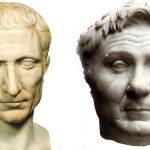Pliny the Elder died during the eruption of Vesuvius in 79 CE. Scientists want to confirm that the body found a hundred years ago belonged to the famous fleet commander and writer.
Pliny the Elder led a rescue operation that was to save the inhabitants of Pompeii from the massive eruption of a neighboring volcano. According to Pliny the Younger, his uncle and then his adoptive father reached the beach, where a cloud of toxic gases killed him. It is believed that rescue ships saved about 2,000 people from the city.
In the early 1900s, engineer Gennaro Matrone discovered about 70 Roman skeletons near the coast in Stabia. One of the remains had a triple gold necklace, gold bracelets and a short sword decorated with bone and shells. The man quickly began to claim that he came across the remains of the famous creator of “Natural History”. Other specialists laughed at Matrone, saying that Pliny would not have moved in such dramatic circumstances equipped with a large amount of gold.
The ridiculous Matrone sold all the precious finds, buried the bones, and took only the skull and sword as a souvenir. Over time, these artifacts found their way to the collections of the small Roman museum Museo di Storia dell’Arte Sanitaria. Scientists have estimated over time that gold ornaments and a beautifully decorated sword were often used by the Roman high fleet commander who belonged to the stratum equites – that’s what Pliny came from. Moreover, it was estimated that the skull belonged to a man aged 50; Pliny died at the age of 56 (according to reports of Pliny the Younger).
Based on these conclusions, a proposal began to thoroughly examine the skull: (1) comparing bone morphology with known busts and images of the writer; (2) and examine the isotope signatures on the teeth. These tests are to cost around 10,000 euros, for which collection is planned. After collecting the appropriate amount, the research itself can take up to several months.
So far, scientists have not been able to identify any important figure from the world of the Romans, based on the preserved body. This is primarily due to the fact that the Romans preferred cremation, and in the sarcophagi or tombs not very important people were buried.







